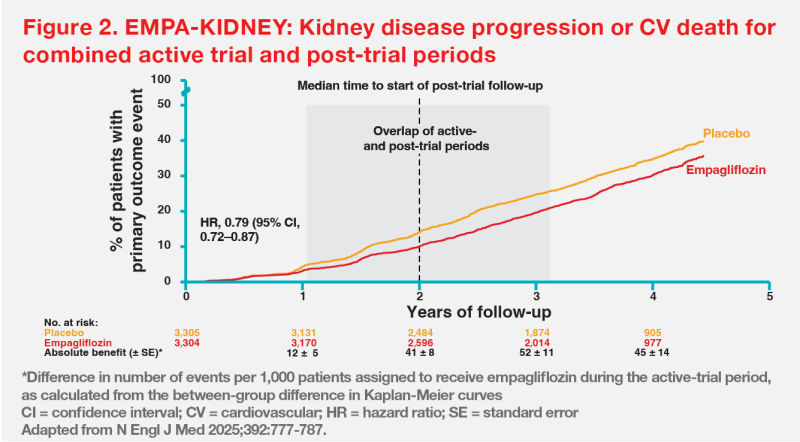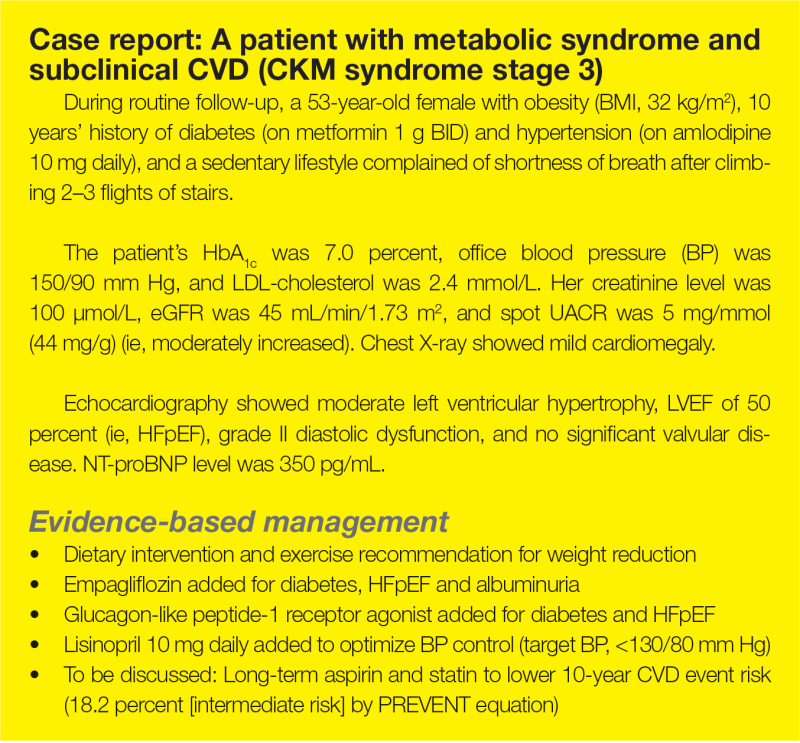CKM syndrome: Strategies for early intervention in primary care











Cardiovascular-kidney-metabolic (CKM) syndrome is a systemic, progressive disorder associated with adverse outcomes in advanced stages. At an industry-sponsored symposium organized by the Hong Kong College of Family Physicians, experts discussed recommendations in the American Heart Association’s (AHA) presidential advisory on CKM health, strategies for early CKM intervention in primary care, as well as guideline recommendations and clinical trial results supporting the use of sodium-glucose cotransporter 2 inhibitors (SGLT2i; eg, empagliflozin) in CKM syndrome.
CKM syndrome: Why does it matter?
According to AHA’s 2023 presidential advisory on CKM health, CKM syndrome is a systemic disorder attributable to interconnections between obesity, diabetes, chronic kidney disease (CKD), and cardiovascular disease (CVD). Both individuals at risk of CVD due to metabolic risk factors and/or CKD and those with existing CVD are considered to have CKM syndrome. (Figure 1) [Circulation 2023;148:1606-1635]

“The culprit of CKM syndrome is excess and dysfunctional adiposity,” said Dr Guang-Ming Tan of the Division of Cardiology, Chinese University of Hong Kong (CUHK). “Pathophysiological interactions among metabolic risk factors, CKD, and the cardiovascular [CV] system lead to multiorgan dysfunction and a high rate of adverse CV outcomes.”
Five progressive stages
CKM syndrome is classified into five progressive stages (stages 0–4), each with specific goals of management. (Figure 1) [Circulation 2023;148:1606- 1635] “Personalized, interdisciplinary and multilevel care is required,” said Tan. “Most of the time, the task of CKM health care falls on the shoulders of primary care physicians, who coordinate multilevel care, while high-risk patients should be managed by specialists.”
Early CKM screening for early detection
AHA’s presidential advisory on CKM health emphasizes early and regular screening for metabolic risk factors and kidney function measures, in addition to diagnostic testing for subclinical atherosclerosis and cardiac dysfunction in select clinical circumstances, to facilitate early detection and appropriate intervention. The goal is to delay or avert the onset of clinical CVD and kidney failure. [Circulation 2023;148:1606-1635] The Hong Kong College of Physicians’ 2025 position statement supports a similar approach. [Hong Kong Med J 2025;31:58-64]
Elevated N-terminal pro-B-type natriuretic peptide (NT-proBNP) is a cardiac biomarker that helps diagnose subclinical heart failure (HF) in at-risk individuals, while coronary artery calcium (CAC) testing helps diagnose subclinical atherosclerotic CVD (ASCVD). “Of note, cardiac biomarkers and CAC testing should be used selectively and only if results are likely to alter clinical decision-making, due to concerns about increased downstream investigations that may be unnecessary,” Tan advised. [Circulation 2023;148:1606-1635; Hong Kong Med J 2025;31:58-64]
“For CKD screening, 2024 guidelines of Kidney Disease: Improving Global Outcomes [KDIGO] recommend measuring glomerular filtration rate [GFR] and albumin-to-creatinine ratio [ACR] annually in at-risk individuals,” said Dr Gordon Chan of the Division of Nephrology, CUHK. “The diagnostic criteria for CKD are estimated GFR [eGFR] <60 mL/min/1.73 m2 using a creatinine-based formula, and/or ACR ≥30 mg/g [≥3 mg/mmol], with chronicity of >3 months.” [Kidney Int 2024;105:S117-S314]
SGLT2i: Recommended therapy for CKM syndrome
“SGLT2i have proven their worth beyond glucose lowering. They are now recommended by guidelines worldwide for management of CKM conditions,” said Dr Ted Wu of the Diabetes Centre, Royal Prince Alfred Hospital in Sydney, Australia, and Shijiazhuang Diabetes Hospital, Hebei, China.
AHA’s 2023 presidential advisory on CKM health recommends SGLT2i for CKM syndrome stages 2–4 (ie, CKD, diabetic kidney disease, diabetes with subclinical HF, clinical ASCVD or HF). [Circulation 2023;148:1606-1635]
The American Diabetes Association’s 2024 guidelines recommend SGLT2i as first-line therapy for patients with type 2 diabetes (T2D) and established ASCVD or indications of high risk, HF, or CKD. [Diabetes Care 2024;47:S158-S178]
“HF guidelines of the European Society of Cardiology [ESC] and AHA/American College of Cardiology/HF Society of America recommend SGLT2i across the spectrum of left ventricular ejection fraction [LVEF], to reduce hospitalization for HF [HHF] or CV mortality,” said Tan. [Eur Heart J 2021;42:3599- 3726; Eur Heart J 2023;44:3627-3639; J Am Coll Cardiol 2022;79:e263-e421]
“SGLT2i are also recommended in ESC’s guidelines on peripheral artery disease [with comorbid T2D], chronic coronary syndromes [with comorbid T2D], and hypertension [with comorbid symptomatic HF with preserved ejection fraction (HFpEF)],” Tan added. [Eur Heart J 2024;45:3538-3700; Eur Heart J 2024;45:3415-3537; Eur Heart J 2024;45:3912-4018]
For CKD management, KDIGO’s guidelines recommend SGLT2i as first-line pharmacotherapy in most patients. SGLT2i can be started if eGFR is ≥20 mL/min/1.73 m2 and continued until dialysis or kidney transplant. [Kidney Int 2024;105:S117-S314]
Never too early to start SGLT2i: Sustained benefits
“It’s never too early to start SGLT2i treatment. The earlier you start, the greater the potential benefit,” pointed out Wu.
T2D + ASCVD: Empagliflozin’s cardiorenal benefits
In patients with T2D and established ASCVD, empagliflozin demonstrated cardiorenal benefits vs placebo in the EMPA-REG OUTCOME trial. The significant reduction in CV death is unique to empagliflozin and has not been observed in CV outcome trials of other SGLT2i. (Table) [N Engl J Med 2015:373:2117- 2128; N Engl J Med 2016;375:323-334; N Engl J Med 2017;377:644-657; N Engl J Med 2019;380:347-357; N Engl J Med 2020;383:1425-1435; Diabetologia 2021;64:1256-1267]

“EMPA-REG OUTCOME’s results also suggest greater estimated survival benefit with starting empagliflozin at a younger age, although its use is linked to longer predicted life expectancy vs placebo at all ages,” said Wu. [Circulation 2018;138:1599-1601]
HF: Early benefit with empagliflozin
Among patients with HF irrespective of T2D status, empagliflozin significantly reduced the risk of CV death or HHF in both the EMPEROR-Reduced trial (HF with reduced ejection fraction) (hazard ratio [HR], 0.75; 95 percent confidence interval [CI], 0.65–0.86; p<0.001) and the EMPEROR-Preserved trial (HF with mildly reduced ejection fraction or HFpEF) (HR, 0.79; 95 percent CI, 0.69–0.90; p<0.001). [N Engl J Med 2020;383:1413-1424; N Engl J Med 2021;385:1451-1461]
“An early benefit was observed at 12 days in EMPEROR-Reduced and at 18 days in EMPEROR-Preserved. This benefit was sustained during the trials’ follow-up period,” highlighted Wu. [Circulation 2021;143:326-336; Eur J Heart Fail 2022;24:245-248] “Given these results, we would be doing our patients a disservice if we don’t start treatment in a timely manner.”
CKD: Empagliflozin’s sustained benefit
Empagliflozin significantly reduced the risk of kidney disease progression or CV death vs placebo (HR, 0.72; 95 percent CI, 0.64–0.82; p<0.001) in a broad population of CKD patients in the EMPA-KIDNEY trial. Unlike previous SGLT2i trials in CKD, EMPA-KIDNEY also included patients with normal to mildly increased UACR. Its eGFR cut-off was the lowest, at 20 mL/min/1.73 m2. [N Engl J Med 2023;388:117-127; N Engl J Med 2019;380:2295-2306; N Engl J Med 2020;383:1436-1446]
“Extrapolated data from EMPA-KIDNEY indicate that it’s almost never too early to start SGLT2i in CKD,” said Wu. “If initiated at an eGFR of 85 mL/min/1.73 m2, empagliflozin treatment may delay kidney replacement therapy [KRT] by 26.6 years vs placebo and avoid >4,000 haemodialysis [HD] sessions per patient. If initiated at an eGFR of 20 mL/min/1.73 m2, empagliflozin treatment may delay KRT by 1.9 years and avoid 301 HD sessions per patient.” [Clin Kidney J 2023;16:1187-1198]
“Notably, empagliflozin’s benefit in CKD persisted after treatment discontinuation, according to long-term data from the trial,” added Chan. (Figure 2) In In the post-trial period, open-label use of SGLT2i (including empagliflozin) was similar between the empagliflozin and placebo groups (43 vs 40 percent). Cardiorenal benefit continued to be observed in the empagliflozin group for up to 1 year post-trial (HR, 0.76; 95 percent CI, 0.60–0.96). [N Engl J Med 2025;392:777-787]

